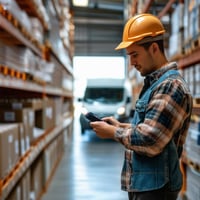The last mile—the final leg of a delivery from the distribution centre to the customer’s...
What is Last-Mile Delivery and Why Does it Matter for Ecommerce?
In ecommerce, the delivery process doesn’t end when an order leaves the warehouse—the journey to the customer’s doorstep is equally important.
This final leg of the delivery process, known as last-mile delivery, plays a critical role in shaping the customer experience.
Last-mile delivery is often the most expensive and complex part of the fulfilment journey, making it a key area for optimisation.
In this blog, we’ll explore what last-mile delivery is, why it matters for ecommerce, and strategies to improve efficiency and satisfaction, whether you are doing in-house fulfilment or partnering with a 3PL.
What is Last-Mile Delivery?
Last-mile delivery refers to the final step of the delivery process, where goods are transported from a transportation hub or warehouse to the end customer’s address.
Key Characteristics:
- Short Distance: Typically involves a small radius, often within a city or region.
- Varied Destinations: Includes residential homes, offices, or pickup locations.
- Customer Expectations: Requires timely, accurate, and sometimes same-day delivery.
Pro Tip: Use GPS tracking and route optimisation tools to streamline last-mile delivery.
Why is Last-Mile Delivery Important for Ecommerce?
Last-mile delivery has a direct impact on customer satisfaction, operational costs, and overall ecommerce success.
Why It Matters:
- Customer Expectations: Modern shoppers expect fast, reliable, and convenient deliveries.
- Brand Reputation: Delays or errors in the last-mile stage can result in negative reviews and lost customers.
- High Costs: Last-mile delivery can account for up to 53% of total shipping costs due to labour, fuel, and logistics.
- Competitive Advantage: Offering options like same-day delivery or flexible time slots can differentiate your brand.
Pro Tip: Prioritise last-mile delivery improvements to boost customer loyalty and drive repeat business.
Common Challenges in Last-Mile Delivery
Last-mile delivery comes with unique challenges that ecommerce businesses must address to remain competitive.
Challenges to Overcome:
- Traffic and Delays: Urban congestion can slow deliveries and increase costs.
- Failed Deliveries: Customers not being available to receive packages adds time and expense.
- High Costs: Labour, fuel, and inefficiencies make last-mile delivery expensive.
- Environmental Impact: Frequent trips and failed deliveries increase carbon emissions.
Pro Tip: Leverage smart technology and alternative delivery models to mitigate these challenges.
Strategies to Optimise Last-Mile Delivery
Improving last-mile delivery efficiency can save costs, enhance customer satisfaction, and reduce your environmental footprint.
Key Strategies:
- Invest in Route Optimisation Software: Use AI and machine learning to plan the fastest, most efficient delivery routes.
- Enable Real-Time Tracking: Provide customers with live updates on their package location and estimated arrival times.
- Use Local Delivery Partners: Collaborate with local couriers for faster, more flexible deliveries in urban areas.
- Offer Pickup Points: Reduce delivery failures by allowing customers to collect packages from nearby lockers or stores.
- Implement Delivery Time Windows: Let customers choose a convenient time slot to ensure successful deliveries.
Pro Tip: Monitor key performance metrics, such as on-time delivery rate and cost per delivery, to assess and refine your strategy.
The Role of Technology in Last-Mile Delivery
Technology is transforming last-mile delivery by enabling faster, smarter, and more efficient operations.
Key Technologies:
- Autonomous Vehicles and Drones: Emerging solutions that reduce labour costs and speed up deliveries.
- Delivery Management Platforms: Centralise order tracking, route planning, and performance analytics.
- AI and Predictive Analytics: Forecast demand and optimise resources to meet delivery requirements.
- Smart Lockers: Provide secure, self-service pickup locations for customers.
Pro Tip: Start with scalable solutions like delivery management platforms before adopting more advanced technologies.
Sustainability and Last-Mile Delivery
Sustainability is becoming a top priority for ecommerce businesses, especially in the last-mile delivery stage, where emissions are highest.
Sustainable Practices:
- Eco-Friendly Vehicles: Use electric vans, bikes, or hybrid vehicles to reduce carbon footprints.
- Consolidated Deliveries: Group orders by location to minimise trips and fuel consumption.
- Carbon Offset Programs: Invest in initiatives that compensate for emissions from deliveries.
- Green Delivery Options: Offer customers the choice of slower, eco-friendly delivery methods.
Pro Tip: Highlight your sustainability efforts in marketing to attract eco-conscious customers.
Conclusion
Last-mile delivery is more than just the final step in the logistics process—it’s a critical touchpoint that directly impacts customer satisfaction and business success.
By addressing common challenges, leveraging technology, and adopting sustainable practices, ecommerce brands can optimise their last-mile operations and stay ahead in a competitive market.
At E-PickPack, we specialise in streamlined, tech-enabled fulfilment solutions designed to enhance last-mile delivery efficiency and customer experience.
Ready to improve your last-mile delivery process? Contact us today to learn how we can help your ecommerce business excel.
FAQs
Q1: What is last-mile delivery?
Last-mile delivery is the final stage in the logistics process, where goods are transported from a warehouse or hub to the customer’s address.
Q2: Why is last-mile delivery so expensive?
Factors like traffic, failed deliveries, and labour-intensive processes contribute to the high costs of last-mile delivery.
Q3: How can ecommerce businesses reduce last-mile delivery costs?
Using route optimisation tools, local couriers, and pickup points can help reduce costs while maintaining efficiency.
Q4: Are drones a viable solution for last-mile delivery?
Drones are an emerging solution for lightweight deliveries, particularly in rural or hard-to-reach areas, but are still in the early adoption phase.
Q5: How does last-mile delivery impact customer satisfaction?
Timely, accurate deliveries enhance the customer experience, while delays or errors can lead to dissatisfaction and lost trust.



